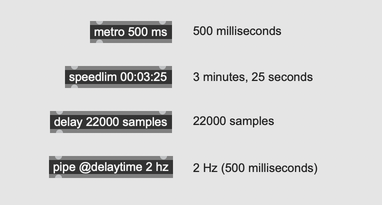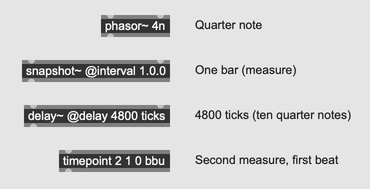Time Value Syntax
Most Max objects that deal with timed events, like metro, phasor~, and pipe, can represent time in multiple ways. In general these fall into two categories: Fixed time values and Tempo-relative time values. Fixed values express time in milliseconds or some other absolute units. Tempo-relative values depend on the current tempo and time signature, as set by a transport object (or the Global Transport).
Fixed Time Values

| Unit | Format | Example | Notes |
|---|---|---|---|
| milliseconds | ms suffix | 100 ms | The default for objects like metro |
| hours/minutes/seconds | : between each number | 01:03:45.250 | 1 hour, 3 minutes, 45 seconds, and 250 milliseconds. The millisecond value after the decimal is optional. |
| hours/minutes/seconds | list of 3 or 4 numbers, followed by hh:mm:ss | 1 3 45 250 hh:mm:ss | An equivalent option for representing time in terms of hours/minutes/seconds/milliseconds |
| samples | samples suffix | 1000 samples | The actual duration will depend on the sample rate |
| frequency | hz suffix | 5 hz | The inverse of milliseconds, so 2 hz is equivalent to 500 ms. |
Tempo-relative Time Values

All Tempo-relative Time Values can be expressed in terms of ticks, where one tick is of a quarter note (equivalently, there are 480 ticks in one quarter note).
| Unit | Format | Example | Notes |
|---|---|---|---|
| ticks | ticks suffix | 100 ticks | In places where only tempo-relative time values are allowed, such as the @quantize attribute of the metro object, values in ticks can be specified as a single number. In places where both fixed and tempo-relative units are accepted, such as the @interval attribute of a metro object, a value in ticks must be followed by ticks to be interpreted as ticks instead of milliseconds. |
| note values | see "Note Values" table | 4nt | Symbols that abbreviate musical note time values—see the table below for recognized values. |
| bars/beats/units | . between each number | 2.4.240 | 2 bars, 4 beats, 240 ticks. When you need to use a single value, bars/beats/units can be separated by periods. |
| bars/beats/units | three numbers | 2 4 240 | When you can pass a list of values, bars/beats/units can be specified by separate numbers like this. When an object will accept Fixed or Tempo-relative time values, you can add bbu to make sure the list is understood as bars/beats/units and not hours/minutes/seconds. |
Note Values in Ticks
| Note | Ticks | Interpretation |
|---|---|---|
| 1nd | 2880 ticks | Dotted whole note |
| 1n | 1920 ticks | Whole note |
| 1nt | 1280 ticks | Whole note triplet |
| 2nd | 1440 ticks | Dotted half note |
| 2n | 960 ticks | Half note |
| 2nt | 640 ticks | Half note triplet |
| 4nd | 720 ticks | Dotted quarter note |
| 4n | 480 ticks | Quarter note |
| 4nt | 320 ticks | Quarter note triplet |
| 8nd | 360 ticks | Dotted eighth note |
| 8n | 240 ticks | Eighth note |
| 8nt | 160 ticks | Eighth note triplet |
| 16nd | 180 ticks | Dotted sixteenth note |
| 16n | 120 ticks | Sixteenth note |
| 16nt | 80 ticks | Sixteenth note triplet |
| 32nd | 90 ticks | Dotted thirty-second note |
| 32n | 60 ticks | thirty-second note |
| 32nt | 40 ticks | thirty-second-note triplet |
| 64nd | 45 ticks | Dotted sixty-fourth note |
| 64n | 30 ticks | Sixty-fourth note |
| 128n | 15 ticks | One-hundred-twenty-eighth note |
Positions vs Intervals
Some objects will interpret a Tempo-relative value in bars/beats/units as a position, while others will interpret the same value as an interval. For example, the timepoint object fires an event at a point in time, and would interpret the bars/beats/units value 1 1 0 bbu as a point in time on the first beat of the first measure—in other words at time zero. Attributes like the @quantize attribute of metro on the other hand wil interpret the same value 1 1 0 bbu as an interval of one bar and one beat, or 5 beats in time (interval, quantization, and delay attributes of objects are generally time intervals).
The translate object has a @mode attribute that can convert time units as either intervals or positions.